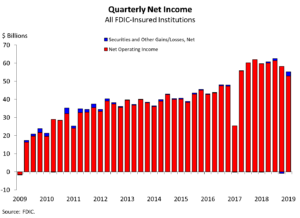 Banks pulled in net income totaling $55.2 billion in fourth quarter 2019, a decline of $4.1 billion (6.9 percent) from a year ago. It’s also down from 3Q 2019’s $57.4 billion. The decline was led by lower net interest income and higher expenses at the country’s 5,177 commercial banks and savings institutions insured by the FDIC.
Banks pulled in net income totaling $55.2 billion in fourth quarter 2019, a decline of $4.1 billion (6.9 percent) from a year ago. It’s also down from 3Q 2019’s $57.4 billion. The decline was led by lower net interest income and higher expenses at the country’s 5,177 commercial banks and savings institutions insured by the FDIC.
“The banking industry remains strong, despite declines in full-year and quarterly net income,” said FDIC Chair Jelena McWilliams. “Loan balances continue to rise, asset quality indicators are stable, and the number of ‘problem banks’ remains low.”
The banking industry reported full-year 2019 net income of $233.1 billion, down $3.6 billion (1.5 percent) from 2018. The decline in net income was primarily due to slower growth in net interest income and higher loan-loss provisions. Lower noninterest income also contributed to the trend.
The decline was broad-based, as nearly half (45.6 percent) of all institutions reported annual declines in net income. The share of unprofitable institutions remained stable from a year ago at 7.2 percent. Net interest income fell by $3.4 billion (2.4 percent) from a year ago, the first annual decline since 3Q 2013.

“Community banks reported another positive quarter,” McWilliams said. “Net income at community banks improved because of higher net operating revenue, and the annual loan growth rate at community banks exceeded the overall industry.”
The 4,750 institutions the FDIC defines as community banks reported quarterly net income of $6.4 billion, up $270.3 million from a year ago. More than half (53.9 percent) reported net income growth. Net interest income increased by 2.1 percent because of strong annual loan growth (up 5.5 percent).
Average community bank net interest margin fell by 15 basis points to 3.62 percent in the fourth quarter, but still beat the industry-wide average of 3.28 percent (down 20 basis points from 2018). Those numbers were 3.67 percent and 3.36 percent for 2019 as a whole, respectively.
Average return on assets at community banks was 1.20 percent for the year, up one basis point from 2018, and 1.15 percent in the fourth quarter. At all banks, average ROA declined from 1.35 percent in 2018 to 1.29 percent in 2019 (1.20 percent in the fourth quarter).
Total loan and lease balances industry-wide increased by $99.5 billion (1 percent) from the previous quarter. Growth among major loan categories was led by consumer loans, which includes credit cards (up $31.3 billion, or 1.8 percent) and residential mortgage loans (up $22 billion, or 1 percent).
Over the past year, total loan and lease balances rose by 4.6 percent, slightly above the 4.5 percent annual growth rate reported last quarter. Commercial and industrial loans registered the largest dollar increase from a year ago (up $131.9 billion, or 6.3 percent).
“While business lending moderated in the fourth quarter amid policy and trade uncertainty, overall bank lending grew by more than $360 billion over the course of 2019, with loans up in nearly every category including business, consumer and real estate,” said James Chessen, economist for the American Bankers Association. “The Federal Reserve’s recent rate cuts have narrowed banks’ net interest margins but have also helped support continued economic growth.”
During the fourth quarter, three new banks opened, 77 institutions were absorbed by mergers, and three banks failed.
